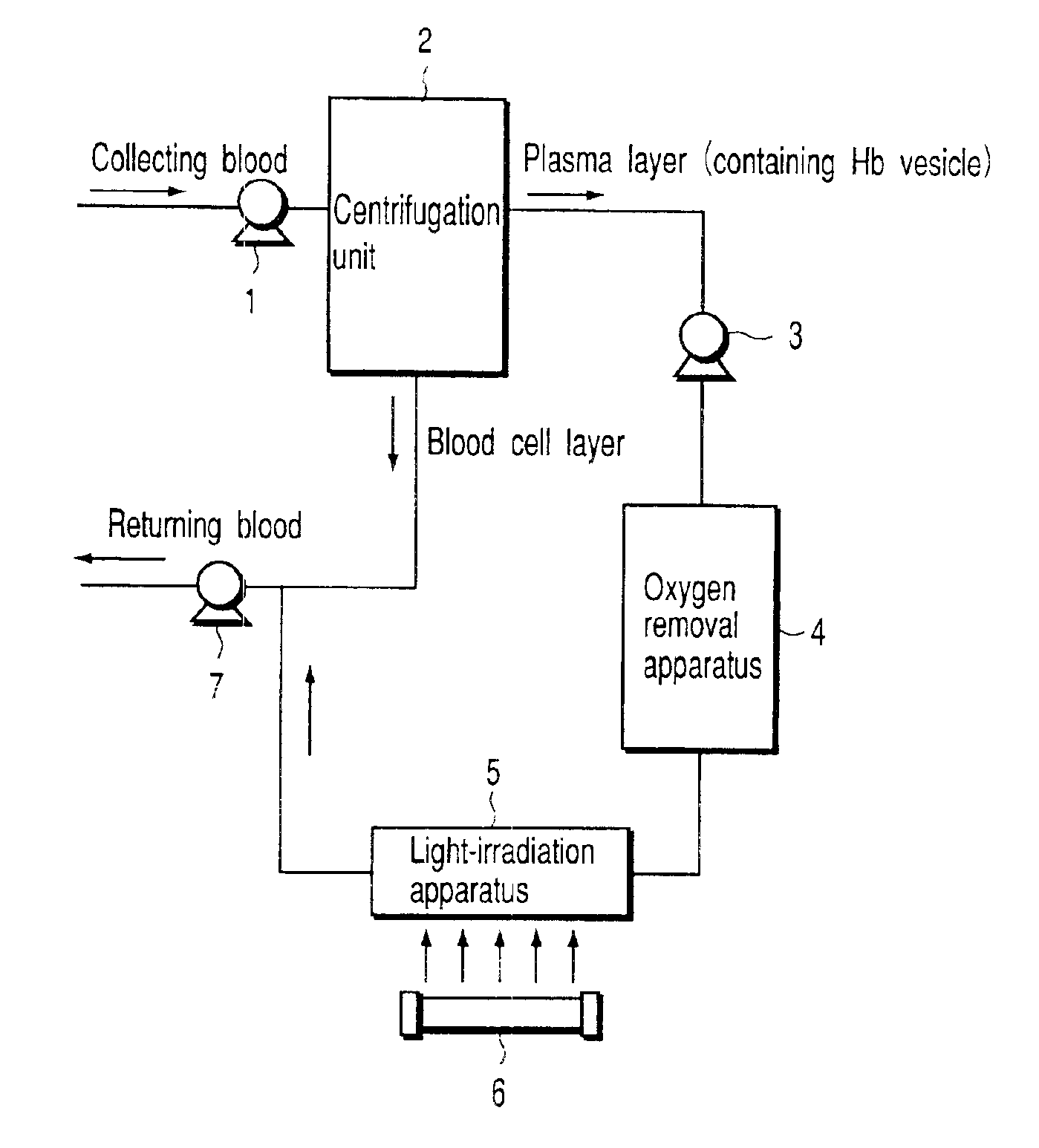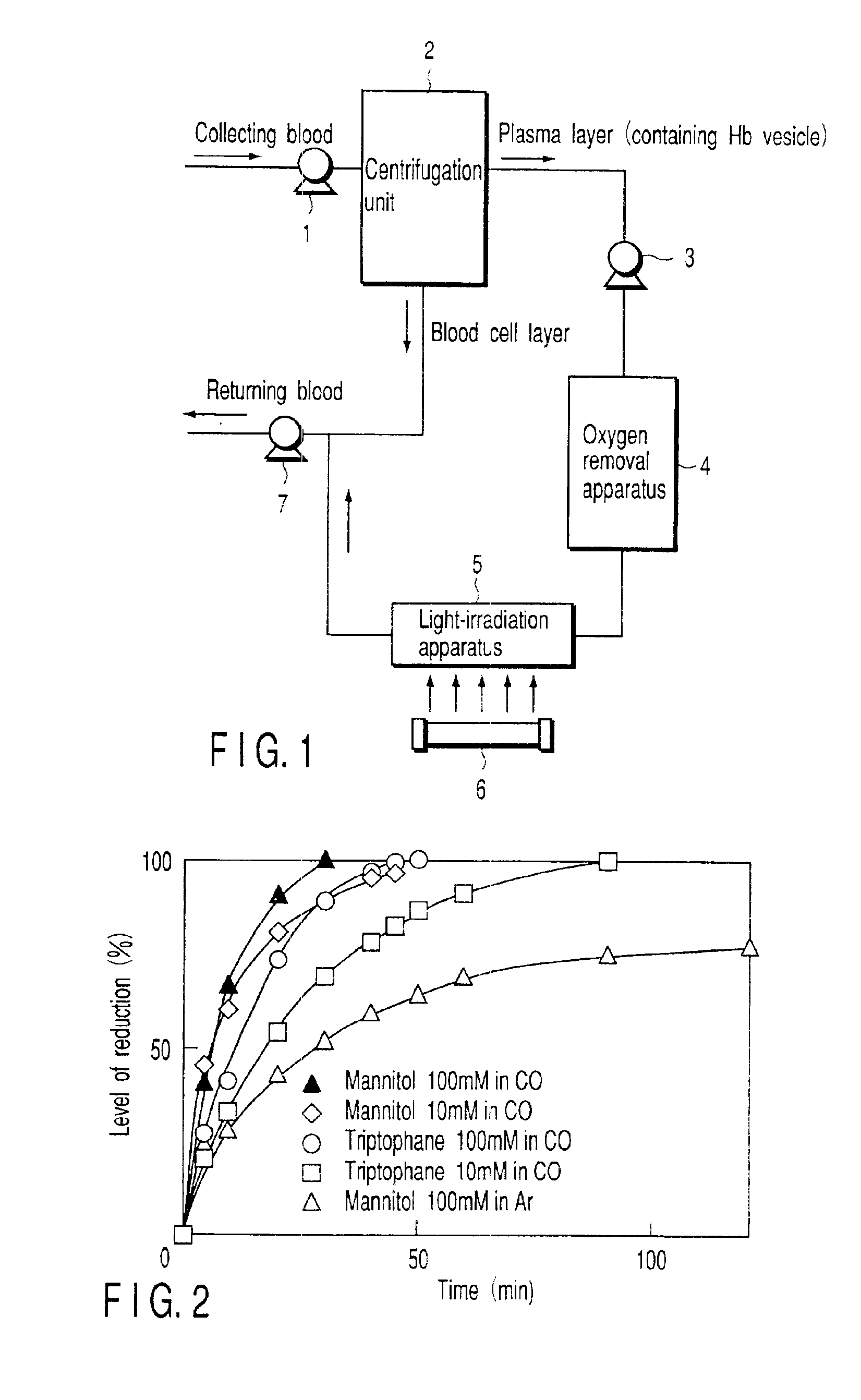Photoreduction method for hemoglobin-vesicle
a hemoglobin and photoreduction technology, applied in the field of hemoglobinvesicle photoreduction, can solve the problems of human blood not being given to patients, contamination of storage, and decreasing the number of healthy blood donors
- Summary
- Abstract
- Description
- Claims
- Application Information
AI Technical Summary
Benefits of technology
Problems solved by technology
Method used
Image
Examples
example 1
[0044]Under a sterile atmosphere, mannitol was added to a highly purified stroma-free hemoglobin solution (40 g / dL, 6.2 mM), which was purified from human erythrocytes from donated blood, to bring final concentrations of 10 mM and 100 mM. The molar ratios of mannitol / hemoglobin of the two solutions were 1.6 and 16, respectively. The resultant solutions were filtrated by use of Remolino™ (Manufactured by Japan Millipore) with an FM micro-filter (manufactured by Fuji Photo Film Co., Ltd.) of 0.22 μm to obtain stock hemoglobin solutions. A lipid-powder mixture, Presome PPG-1, i.e., mixed lipid powder (a mixture of phosphatidylcholine / cholesterol / phosphatidyl glycerol, manufactured by Nippon Seika Co.), was added little by little to bring the concentration of lipid to 4.5 wt %. The mixture was stirred at 4° C. overnight to obtain multi-layered vesicle containing hemoglobin. At this time, the particle diameter and the number of coating lipid layers were controlled by an extrusion method ...
example 2
[0046]The methemoglobin-vesicle (prepared in Example 1) having 100 mM mannitol in its inner aqueous phase was loaded into a quartz cell to bring the concentration of methemoglobin to 2.5 μM. Light was applied under an argon atmosphere in the same manner as mentioned in Example 1. As a result, the absorbance at the wavelength of 430 nm due to deoxyhemoglobin increased, and 80% of reduction was performed for 120 minutes. When the mixture was aerated with oxygen, an absorbance peak appeared at the wavelength of 415 nm. This observation confirmed that oxyhemoglobin (oxygen-binding hemoglobin) vesicle was produced.
example 3
[0048]In the method of preparing the hemoglobin-vesicle according to Example 1, triptophane was used in place of mannitol. To be more specific, triptophane was introduced into inner-aqueous phase of hemoglobin-vesicles in an amounts of 10 mM and 100 mM in accordance with the same preparation method as in Example 1. As a result, hemoglobin-vesicles with triptophane included therein were obtained. The molar ratios of triptophane to hemoglobin used herein were 1.6 and 16, respectively. When the incubation was performed at 37° C. for 48 hours, the content of methemoglobin reached 42%. This mixture was loaded into a quartz cell to bring the concentration of methemoglobin to 2.5 μM, and then, aerated with carbon monoxide. Light having wavelength around 365 nm was applied in the same manner as in Example 1. The maximum absorption wavelength of 405 nm inherent to methemoglobin was gradually decreased, and a peak at 419 nm was increased in place. This means that methemoglobin contained in th...
PUM
| Property | Measurement | Unit |
|---|---|---|
| wave length | aaaaa | aaaaa |
| ultraviolet/visible wavelength | aaaaa | aaaaa |
| diameters | aaaaa | aaaaa |
Abstract
Description
Claims
Application Information
 Login to View More
Login to View More - R&D
- Intellectual Property
- Life Sciences
- Materials
- Tech Scout
- Unparalleled Data Quality
- Higher Quality Content
- 60% Fewer Hallucinations
Browse by: Latest US Patents, China's latest patents, Technical Efficacy Thesaurus, Application Domain, Technology Topic, Popular Technical Reports.
© 2025 PatSnap. All rights reserved.Legal|Privacy policy|Modern Slavery Act Transparency Statement|Sitemap|About US| Contact US: help@patsnap.com


